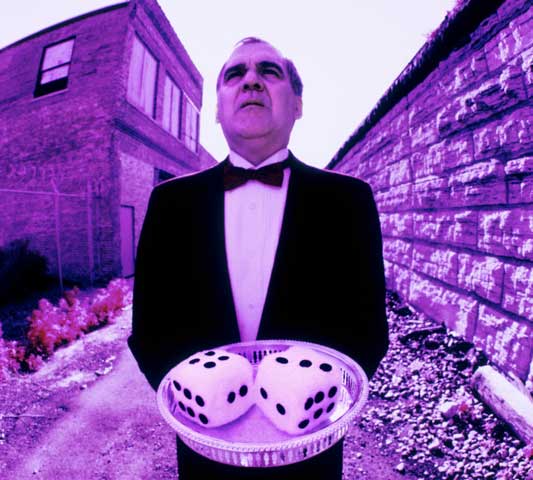
Technically the Sony F35 isn’t sensitive to infrared, but it is sensitive to far red. The difference will save you a lot of money on filters.
Before we start, it might be a good idea to take a look at this article to refresh your memory as to where in the spectrum IR/far red filters cut, and why they become important under certain conditions.
The methodology for this test was similar to the RED test: each shot was recorded digitally, although in this case to a Panasonic HPM-110 P2 deck in AVC-Intra fed via the camera’s HD-SDI port. I exported a frame from each shot into Photoshop and color corrected it in the same way I described in the RED Hot Mirror shoot-out article.
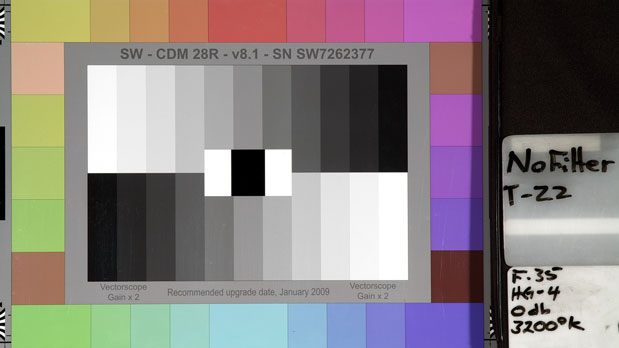
In the center is a DSC Chroma Du Monde chart lit with two tungsten Arri 1k open-face lights. Behind the slate is the chart’s polyester case, which is an excellent source of reflected IR/far red.

The F35 is so sensitive that we were able to achieve a stop of T22, using Arri/Zeiss Ultra Primes and no filtration.
For several of the filters we did a flat field test in order to detect off-angle color fringing due to dichroic coatings:
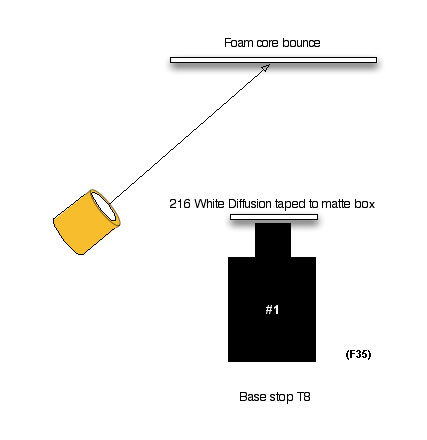
This is what the 16mm Ultra Prime looked like at T8:
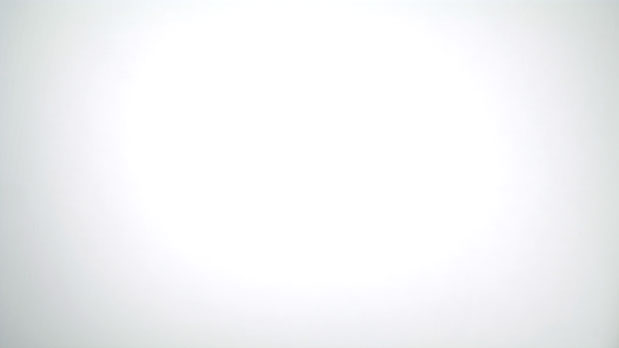
This lens shows some vignetting at certain T-stops so keep that in mind when looking at the flat field tests. What we’re looking for are color shifts around the edges of the frame, not brightness shifts.
On to the tests…
IS THERE ANYTHING TO WORRY ABOUT?
We took a look to see if there’s anything to worry about when using ND filtration on the F35. Once again, here’s the camera with no filtration:

Here’s the same shot with a Schneider ND .30 filter:
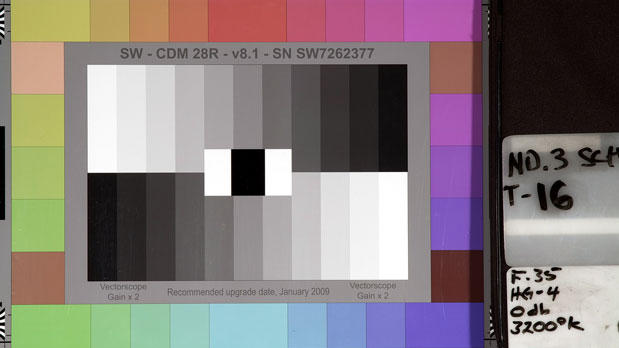
At this point we saw a tinge of red contamination in the black DSC chart bag, which was quite surprising when using so little ND. It doesn’t read quite as strongly in this JPEG but it was very apparent on our monitor.
We swapped the ND .30 out for an ND .60:
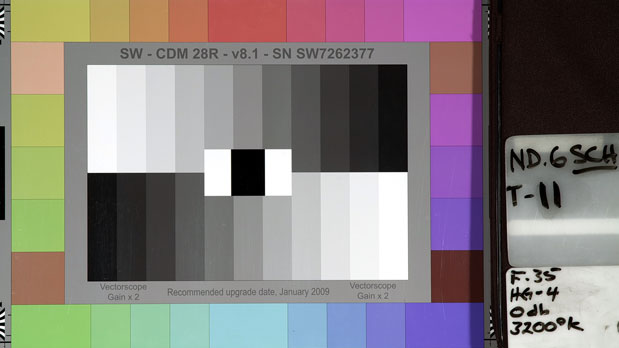
Now we can definitely see the chart bag take on a reddish hue that wasn’t visible to our eyes. In the interest of time we jumped right to the heaviest possible filter pack we could use under our test conditions, the Schneider ND .9 and ND 1.2:
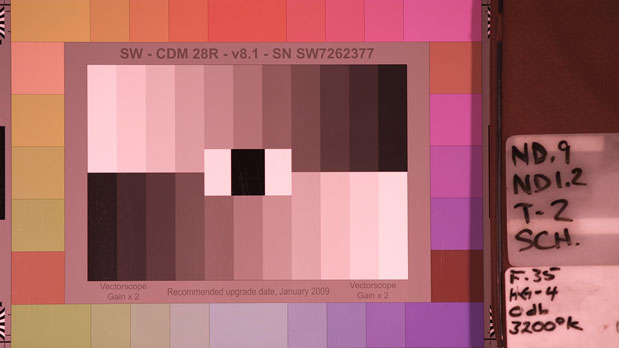
The overall red cast is normal. It’s extremely hard to make a neutral density filter that is truly neutral in color, and the more ND one uses the more obvious the color shift becomes. Due to the F35’s ability to see a much broader spectrum of color than other cameras, it is extremely sensitive to small shifts in hue that wouldn’t be much of an issue on other cameras. For this reason the F35 is equipped with a number of digital white balance slots to compensate for hue shifts in different filter packs.
The true test is when we white balance this image and see what color the chart bag really is:
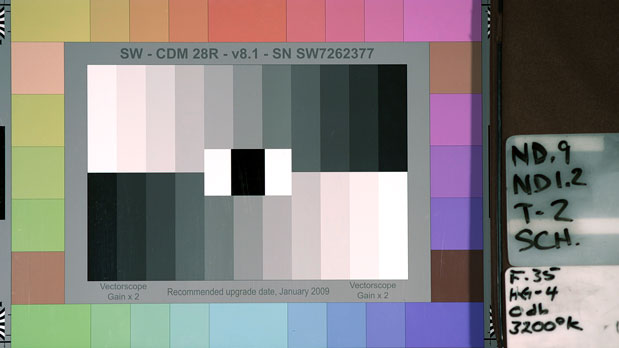
And there it is: significant IR or far red contamination in the DSC chart bag. This image is much more subdued than what we saw on a CRT, where the black polyester of the chart bag was a rich maroon.
So far there aren’t any surprises here. Let’s move on to the filter tests and see if we can figure out how good the sensor’s built-in IR cut filter really is…
FIRST UP: SCHNEIDER OPTICS HOT MIRRORS
I’ve been informed by Sony engineers that the F35 has a 700nm cut filter built onto the sensor, which would mean that the red contamination we’re seeing is far red, not IR. Far red is at the edge of the visible spectrum and is a color of light that our eyes can’t see very well, if at all, but it is not yet pure infrared heat. The far red “leak” typically occurs between where ND filters start passing non-visible light (around 680nm) and where the IR filter on the sensor cuts (700nm).
We’re about to find out whether that’s true or not. Schneider Optics kindly provided me with three filters to test: a 680nm cut filter, a 720nm+ND 1.2 combination filter, and a 750nm cut filter. If there really is a built-in 700nm cut filter on the chip then we should see some results from the 680nm filter, but not the others.
First, here’s the 680nm filter:
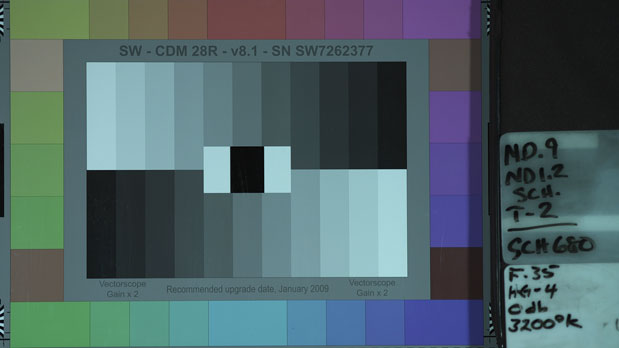
This is the Schneider Tru-Cut IR 680 filter, in combination with a Schneider ND .9 and ND 1.2. It has a very strong dichroic coating, which gives it a cyan cast and costs between a half stop and a full stop of light. As we’ve seen, an overall color cast isn’t an issue at all: what’s important is what’s left once we white balance through it.
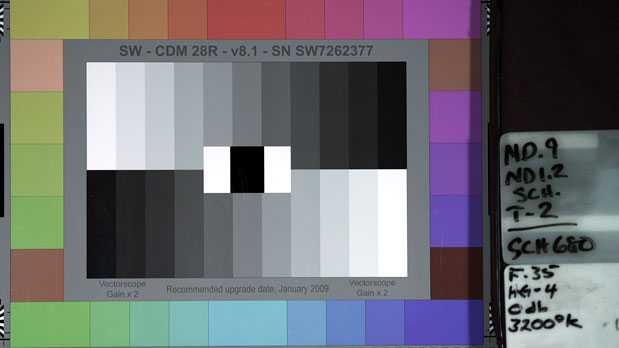
The Tru-Cut 680 does an excellent job of removing all far red or IR contamination from this shot.
BUT…
Here’s the flat field test, with the Tru-Cut 680 on a 16mm Ultra Prime:

Dichroic coatings tend to show up most when viewed at an angle other than perpendicular, and in this case the lens angle of view is too extreme around the edges of the filter. Let’s look at a 24mm lens:
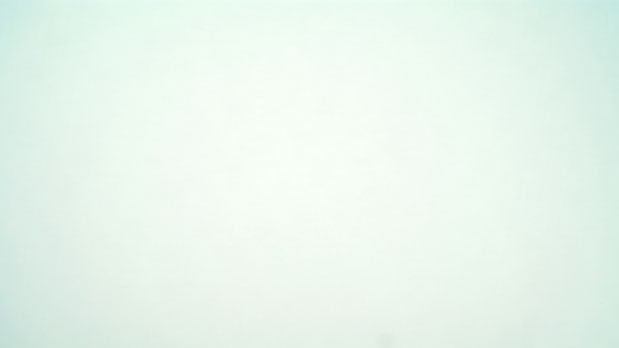
Better, but there’s still an obvious cyan cast to the edges of the frame. Let’s see if the 32mm works:
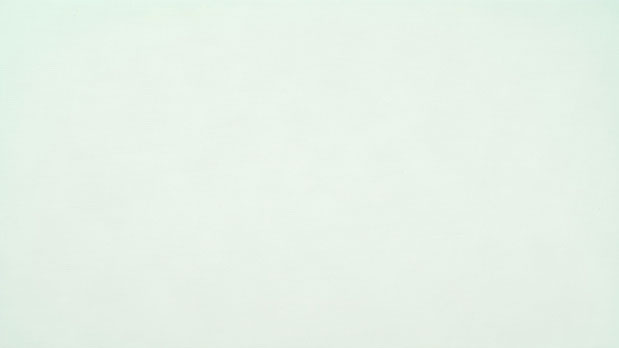
At this point it appears safe to say that the cyan edges have given way to an overall cyan cast that can be easily white balanced away. Let’s take one more look, this time at a 50mm lens:
This image looks virtually the same as the 32mm, which means that 32mm is the widest lens one could safely use with the Tru-Cut 680 to avoid color vignetting.
The next filter in the Schneider series is the Tru-Cut IR 720 + ND 1.2 combo:
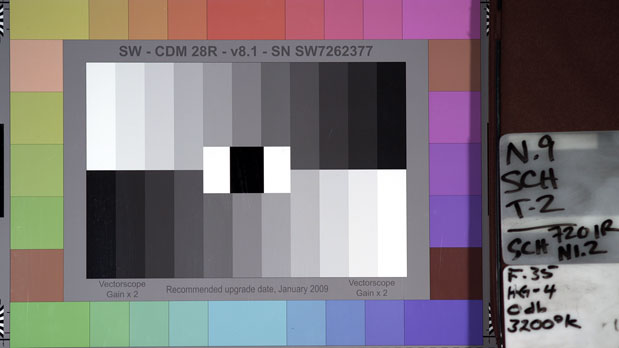
It seems that Sony’s engineers were correct. The 720 filter shows virtually no effect. The final Schneider filter is the Tru-Cut 750:

This filter has no effect at all, and when we compared the two filters we discovered that the 720 had some effect but not nearly enough. This can be explained by the sensor’s IR filter having a gradual roll-off effect that starts at 700nm, instead of a hard cut of everything above 700nm.
Just for the record, here are the flat field tests on the Tru-Cut 720 and 750 filters. First, the 720 as viewed through a 16mm lens:
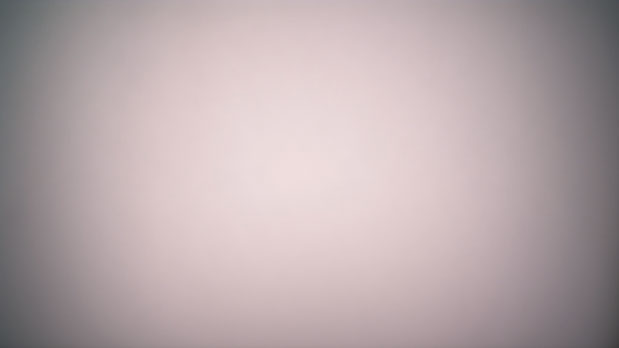
And then the 750, viewed through the same lens:
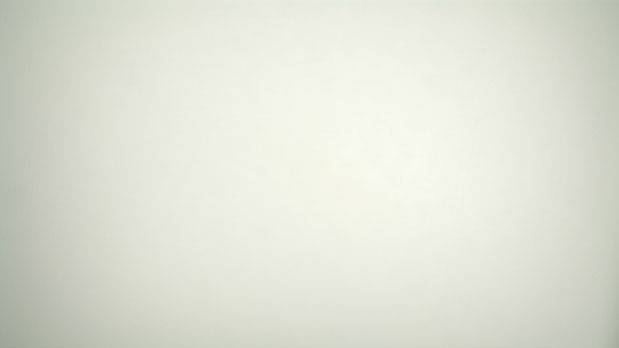
We saw no evidence of a color vignette, only an overall color shift that is easily removed by white balancing.
While these filters don’t work so well with the F35 they do have some positive results on the RED.
Let’s move on to Formatt’s offerings…
SECOND UP: FORMATT
We tested three Formatt Hot Mirror filters on the F35. There was no indication as to what wavelength they cut, but this chart from the Formatt web site gives us a clue:

The numbering is a little confusing. If we assume each square is 100nm, then the “750.0” text indicates where the cut occurs on the graph, and does not correlate to the vertical line above it. Counting from the left, the vertical line above the “750.0” text should indicate 800nm, with the filter cut occurring halfway between the 700nm and 800nm marks.
If this graph is telling us that the Formatt Hot Mirror cuts at 750nm and above, and knowing from the previous test that the F35’s on-sensor Hot Mirror starts cutting at 700 and rolls off completely by 750, then the Formatt Hot Mirror should show no effect on far red contamination on the F35. Here’s the Formatt Hot Mirror filter, in combination with normal Schneider ND .90 and 1.2 filters:
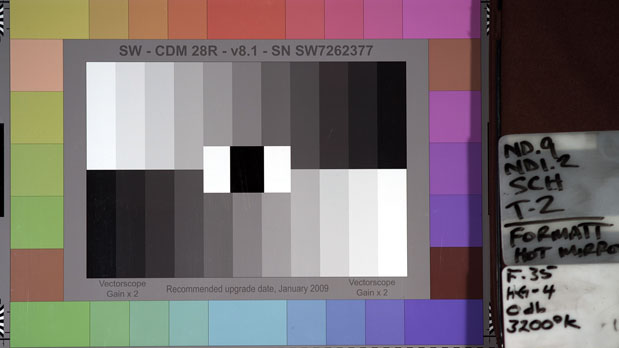
Here’s the Formatt Hot Mirror + ND 2.1 combination filter:
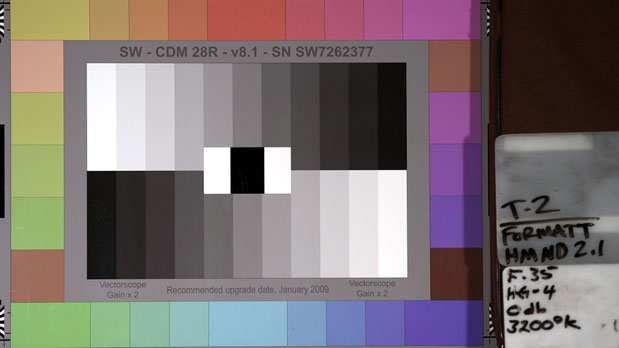
There’s no effect at all, which is what we’d expect from a filter with a 750nm cut, based on the Schneider Tru-Cut tests.
Just for fun we combined the Formatt Hot Mirror ND 1.2 with a regular Schneider ND .90:
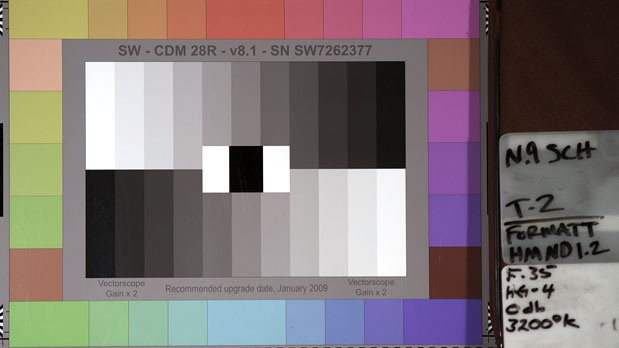
This combination seems to pass slightly more far red, showing that whatever Formatt is doing to cut IR and far red is proportionate to the filter strength. This implies that it would be a bad idea to combine the Formatt Hot Mirror ND filters with regular ND’s.
Here’s the flat field test of the Formatt Hot Mirror on a 16mm lens:
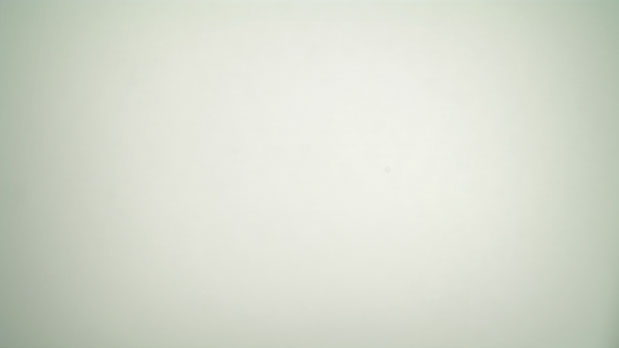
The F35 does seem to see a subtle greenish vignette around the edges of the frame.
While these filters don’t work so well with the F35 they do have some positive results on the RED.
Last but not least, lets see what Tiffen has to offer…
THIRD UP: TIFFEN
Tiffen offers two brands of IR/far red filters: the Tiffen Hot Mirror IR ND’s and the Tiffen IR ND filters (non-Hot Mirror). We were told, in no uncertain terms, NOT to use the Hot Mirror filters on the F35. We did anyway, and discovered that there was no measurable difference between the filter brands… unless you looked at the prices. More on this later.
At present Tiffen offers only IR combination filters, and not a straight IR filter alone. We tried the Tiffen IR ND 2.1 filter:
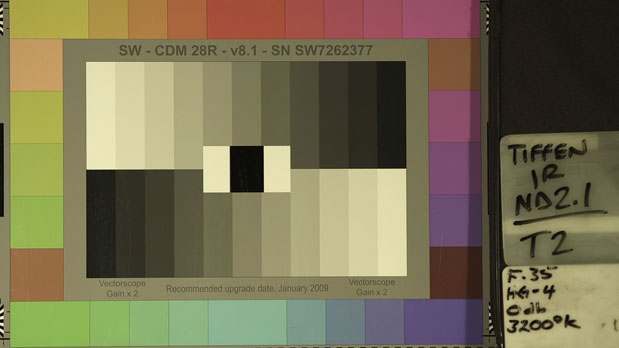
This filter, like the others, has a color cast to it, although it’s more of a yellow-green than the others, which tended to look more cyan. Here’s what’s left when we white balanced to remove the yellow-green cast:
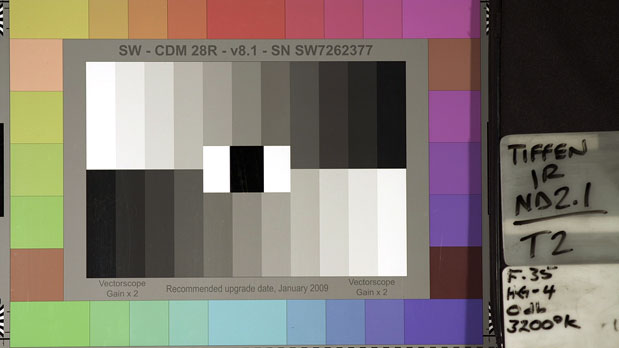
Um… (gulp) wow! This filter works perfectly. But there’s something wrong…
THERE’S NO DICHROIC LAYER ON THIS FILTER.
It appears to be dyed a magic yellow-green color that removes all trace of far red from the chart bag. So, based on what we know:
(1) The F35 sensor’s Hot Mirror seems to start cutting at 700nm and cuts completely by 750nm
(2) All the other filters have dichroic layers, as evidenced by their change in color when viewed at extreme angles
(3) This filter seems to act only on far red using dye technology
My deduction is that Tiffen has found a dye that is the perfect complement to the 680nm-750nm range of far red that causes problems on this camera, completely eliminating both the need for dichroic layers and the danger of color vignetting on wider lenses.
It’s brilliant.
There is one very, very, very important thing to know, however, when using the Tiffen IR ND filters:
You must never combine these filters with regular ND’s, because the amount of yellow-green used to cut far red is proportionate to the strength of the ND. That means that the yellow-green hue of a Tiffen IR ND 1.2 will be lighter than a Tiffen IR ND 2.1, which requires stronger far red correction. If you combine a Tiffen IR ND .9 with a regular ND 1.2, you are only getting ND .9 worth of far red blockage–because the Tiffen IR ND .9 filter only has enough color in it to block ND .9 worth of far red, and the additional far red passing through the ND 1.2 will not be blocked.
Here’s a quick F35 test I snuck in while writing up my RED IR article. The following image utilizes only the Tiffen IR ND 1.2 filter:
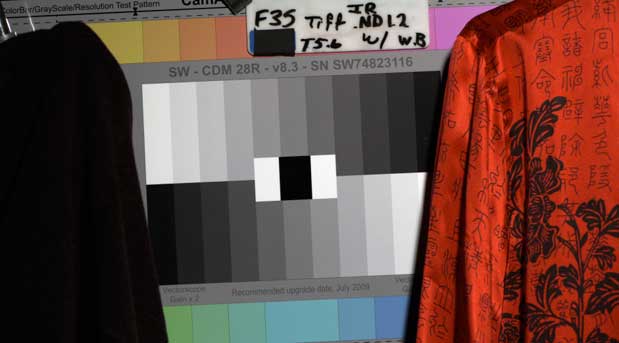
The next image utilizes the Tiffen IR ND 1.2 filter in conjunction with a REGULAR Schneider ND .90 filter:
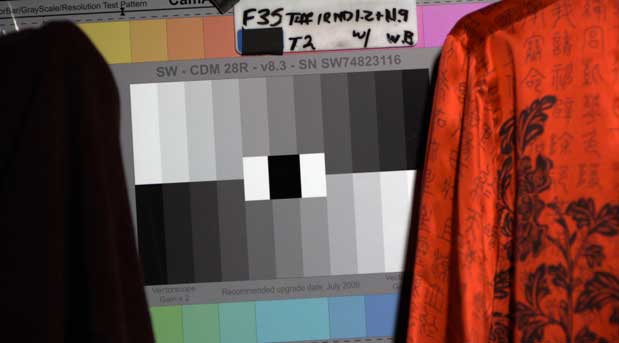
It’s very subtle, but in the second image there is a slight reddish-maroon coloring to the black jacket on the left of frame. This seems to prove Tiffen’s claim that the far red filtration in its IR ND filter line is proportional to the ND strength and should not be combined with regular ND’s. (And the same seems to be true of Formatt’s Hot Mirror ND’s, probably for a similar reason.)
There is one very, very, very important thing to know when BUYING Tiffen filters:
The Tiffen IR ND is made specifically for the F35, based on research done with the Panavision Genesis. The F35 is an updated version of the Genesis, and as the IR cut filter in front of the sensor on both cameras does a very good job of cutting IR, but not a very good job of cutting far red, you should ONLY buy the IR ND filters for use with the F35 and the Genesis. The Tiffin Hot Mirror ND line of filters incorporates a dichroic Hot Mirror into the filter, which is not only useless when used on the Genesis or the F35 but also costs about US$400 more per filter than the Tiffen IR ND line.
The Tiffen Hot Mirror ND filters work best on cameras like the RED, which don’t have very effective Hot Mirrors on their sensors and pass both far red AND infrared.
Raise your hand if you think Tiffen made a mistake by giving these two filter lines such similar names.
The summary is on the next page…
Here’s what we learned from this test:
The Sony F35, like the Panavision Genesis, is sensitive to far red, not infrared. It has a very effective Hot Mirror filter on the sensor but, with almost any amount of ND in front of the lens, synthetic fabrics and some kinds of dye will turn red or maroon due to far red contamination.
The problem can be noticeable when using as little as an ND .30 filter, but is definitely noticeable at ND .60.
Hot Mirror filters do not, on their own, solve this issue. Hot Mirrors, or filters with dichroic coatings, are designed to cut at different wavelengths, and some of the cuts are too high to have any effect. A dichroic Hot Mirror that cuts at 720nm will have some effect, while those that cut at 750nm have no effect.
The Schneider Tru-Cut 680 filter, which cuts at 680nm, works very well on the F35 but causes severe cyan vignetting on wide angle lenses due to the off-angle color change exhibited by dichroic filters. This vignetting is unacceptable on lenses wider than 32mm.
Tiffen IR ND filters do as good a job at cutting far red on the F35 as the Schneider Tru-Cut 680 does, but without the dichroic coatings that can cause color vignetting on wide lenses.
Tiffen IR ND filters CAN NOT be combined with regular ND’s, as the amount of far red filtration built in to the IR ND line of filters is proportional to the amount of ND. A strong Tiffen IR ND filter will look more yellow-green than a light one.
Do not buy Tiffen Hot Mirror IR ND filters for use with the F35 or the Genesis as that’s a waste of money. Save that enormous expenditure for your cheaper cameras, like the RED.
Thanks very much to Jay Farrington and Chater Camera for their help with this test. Thanks also to camera assistant Rod Williams for his exceptional help, and also to Videofax for their kind assistance in helping with additional F35 filter testing.

Filmtools
Filmmakers go-to destination for pre-production, production & post production equipment!
Shop Now













